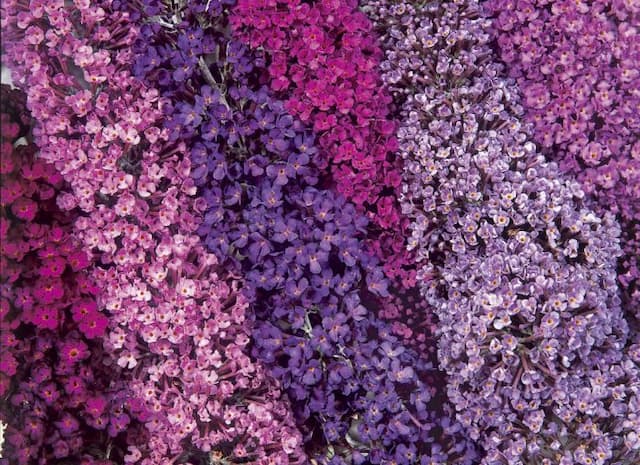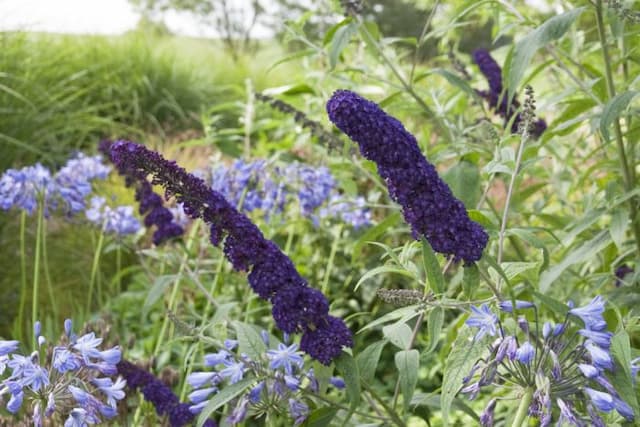Himalayan butterfly bush Buddleja crispa

ABOUT
B. crispa is a deciduous, upright, bushy shrub, up to around 3m in height, bearing racemes of small, pale lavender flowers, with a white eye, from mid to late summer. Oval leaves are felty and grey-green
About this plant
 Names
NamesFamily
Scrophulariaceae
Synonyms
Crispy Butterfly Bush, Himalayan Butterfly Bush
Common names
Buddleja agathosma, Buddleja colvilei var. crispa, Buddleja coriacea, Buddleja crispa var. agathosma, Buddleja heliophila, Buddleja incana var. agathosma, Buddleja macrostachya, Buddleja stenostachya.
 Characteristics
CharacteristicsLife cycle
Perennials
Foliage type
Deciduous
Color of leaves
Silver-green
Flower color
Lilac
Height
6 feet (1.8 meters)
Spread
6 feet (1.8 meters)
Plant type
Shrub
Hardiness zones
7
Native area
Himalayas
Benefits
 General Benefits
General Benefits- Attracts Wildlife: Buddleja crispa is known for attracting butterflies, bees, and other beneficial pollinators, enhancing biodiversity in a garden.
- Ornamental Value: With its attractive silver-grey foliage and clusters of scented lilac-pink flowers, it offers aesthetic value to gardens and landscapes.
- Drought Tolerance: The plant is resilient in dry conditions, making it suitable for xeriscaping or gardens that receive little water.
- Low Maintenance: Requiring minimal care, Buddleja crispa is an excellent choice for gardeners who seek low-maintenance plants.
- Fast Growth: It grows relatively quickly, which can be advantageous for gardeners looking to establish a mature garden swiftly.
- Suitable for Various Soil Types: This plant can thrive in a range of soil conditions, making it versatile for different gardening situations.
 Medical Properties
Medical Properties- Anti-inflammatory: Buddleja crispa may have properties that reduce inflammation.
- Antipyretic: It has been suggested to have fever-reducing effects.
- Antimicrobial: It might possess antimicrobial properties that help to prevent or treat infections.
 Air-purifying Qualities
Air-purifying QualitiesThis plant is not specifically known for air purifying qualities.
 Other Uses
Other Uses- Buddleja crispa can be used as a natural insect repellent in gardens, as some insects may find the scent of its leaves and flowers unattractive.
- The soft woolly texture of the leaves can be used in creating textured collages or as a tactile element in sensory gardens for educational purposes.
- This plant is sometimes used in perfumery for its light and delicate fragrance, which is extracted from the flowers.
- The plant's branches can be woven into small ornamental crafts or used as natural stakes for supporting other plants in the garden due to their sturdy nature.
- Dried Buddleja crispa flowers can be used to make a potpourri, adding a mild soothing fragrance to a room when mixed with other dried herbs and flowers.
- Its fuzzy leaves can serve as a natural scrubbing tool for gentle cleaning of delicate items or surfaces without scratching them.
- The flowers can be used to create a natural dye, which has traditionally been used for coloring fabrics and yarns in a muted palette.
- Gardeners may use the dense foliage of Buddleja crispa to create a privacy screen or windbreak in a landscape design.
- The silver-gray foliage can be used to add a contrasting background in photography or painting, especially to highlight brighter colored subjects.
- Because of its unique texture and form, dried branches of this plant can be used in floral arrangements, adding an exotic touch to bouquets and centerpieces.
Interesting Facts
 Feng Shui
Feng ShuiThe Butterfly Bush is not used in Feng Shui practice.
 Zodiac Sign Compitability
Zodiac Sign CompitabilityThe Butterfly Bush is not used in astrology practice.
 Plant Symbolism
Plant Symbolism- Renewal: The Buddleja crispa often blooms in late winter to early spring, symbolizing the renewal of life and the beginning of a new cycle.
- Attraction: This plant is known for attracting butterflies and other pollinators, signifying the power of attraction and the importance of relationships in fostering growth.
- Adaptation: As Buddleja crispa can thrive in various conditions, it represents the ability to adapt to changing environments and remain resilient in the face of challenges.
- Healing: Traditionally, some species of Buddleja have been used for their medicinal properties, reflecting the symbolic meaning of healing and the nurturing of health.
 Water
WaterThe Butterfly Bush prefers to be watered deeply but infrequently, awaiting the top inch of soil to become dry before the next watering. This typically equates to about 1 gallon per plant every week during the growing season, although this can vary based on climate conditions such as heat and humidity. During the winter or in cooler climates, watering can be reduced. Overwatering can lead to root rot, so ensure good drainage for the plant's health.
 Light
LightThe Butterfly Bush thrives in full sunlight, so choose a spot where the plant can receive at least 6 hours of direct sunlight each day. These conditions will promote the healthiest growth and flowering. While it can tolerate partial shade, flowering may be reduced, so full sun exposure is best for optimal performance.
 Temperature
TemperatureThe Butterfly Bush prefers a temperate climate with temperatures ranging from 60 to 90 degrees Fahrenheit. While it can tolerate down to about 20 degrees Fahrenheit for short periods, frost can damage the plant. The ideal temperature range should be aimed to be maintained, especially during the growing season.
 Pruning
PruningPruning the Butterfly Bush is important to encourage new growth and more abundant flowering. It should be done in late winter or early spring, before new growth starts. This can sometimes be quite severe, cutting back to within a foot of the ground, as the plant flowers on new wood. Remove dead, damaged, or old non-vigorous stems to promote the health of the plant.
 Cleaning
CleaningAs needed
 Soil
SoilHimalayan Butterfly Bush thrives in well-drained soil with a pH ranging from neutral to slightly alkaline. A soil mix consisting of loam, sand, and a small amount of compost is ideal to provide nutrients and proper drainage. Mulching can help retain moisture and regulate soil temperature.
 Repotting
RepottingHimalayan Butterfly Bush does not require frequent repotting; it is typically done every 2 to 3 years. Choose a slightly larger pot to accommodate root growth and refresh the soil to provide renewed nutrients.
 Humidity & Misting
Humidity & MistingHimalayan Butterfly Bush prefers moderate humidity and does not require special humidity conditions. It is quite hardy and can tolerate the humidity levels found in most natural outdoor environments.
 Suitable locations
Suitable locationsIndoor
Ensure bright light, minimal water, and well-draining soil.
Outdoor
Plant in full sun, shelter from strong wind, well-drained soil.
Hardiness zone
7-9 USDA
 Life cycle
Life cycleThe life cycle of Buddleja crispa, commonly known as Butterfly Bush, begins with seed germination, occurring in warm, well-drained soil with plenty of sunlight. Once sprouted, the seedling grows rapidly, developing into a young plant with oval, textured leaves and a silvery hue. As the plant matures, it forms a woody shrub structure with arching stems; this stage can last several years given the proper conditions. Flowering typically occurs in the late spring to summer, exhibiting clusters of small, tubular, and fragrant flowers that may vary in color from pink to purple, attracting pollinators such as butterflies and bees. After pollination, the plant produces small capsules of seeds that ripen and are released in late summer to autumn. Finally, the Butterfly Bush may enter a period of dormancy in winter, particularly in cooler climates, before resuming growth in the following spring.
 Propogation
PropogationPropogation time
Spring to Summer
Buddleja crispa, commonly known as Himalayan Butterfly Bush, is often propagated through semi-hardwood cuttings. This method is typically done in late summer after new growth has matured and begun to harden. A 4 to 6-inch cutting (10 to 15 cm) is taken from the current year's growth, ensuring that at least a couple of sets of leaves are present. The lower leaves are removed, and the cut end is dipped in rooting hormone to encourage root development. The cutting is then planted in a well-draining soil mix, and kept in a warm, humid environment until roots have developed, which usually takes a few weeks. During this time, it's important to keep the soil consistently moist but not waterlogged. Semi-hardwood cuttings have the advantage of already being somewhat established, increasing the likelihood of successful rooting and plant growth.

![Butterfly bush [Adonis Blue]](/_next/image?url=https%3A%2F%2Fplants-admin.emdemapps.com%2Fimages%2Fplants%2F%2Fimages%2F604b56e58f983.png&w=640&q=75)


![Butterfly bush [Buzz Ivory]](/_next/image?url=https%3A%2F%2Fplants-admin.emdemapps.com%2Fimages%2Fplants%2F%2Fimages%2F604b57987dfa8.png&w=640&q=75)
![Butterfly bush [Camberwell Beauty]](/_next/image?url=https%3A%2F%2Fplants-admin.emdemapps.com%2Fimages%2Fplants%2F%2Fimages%2F604b5ead04c12.png&w=640&q=75)



